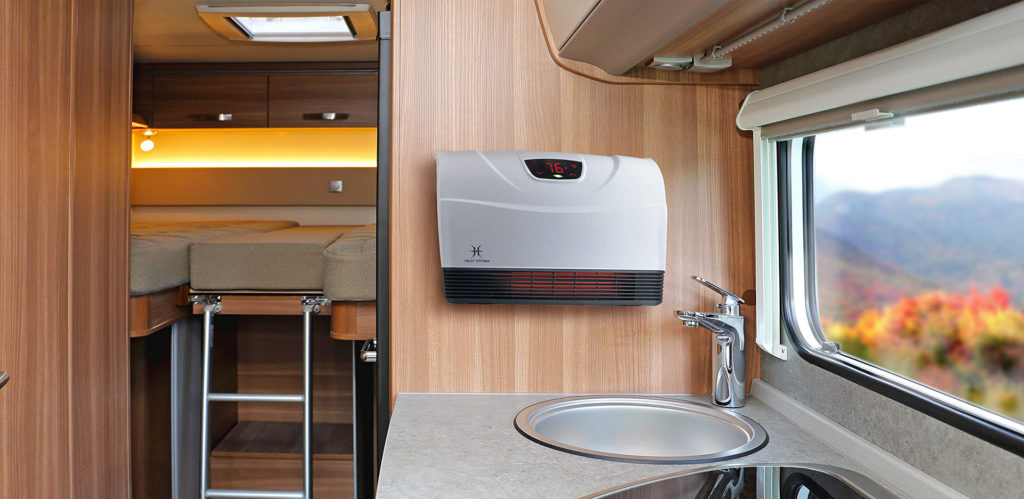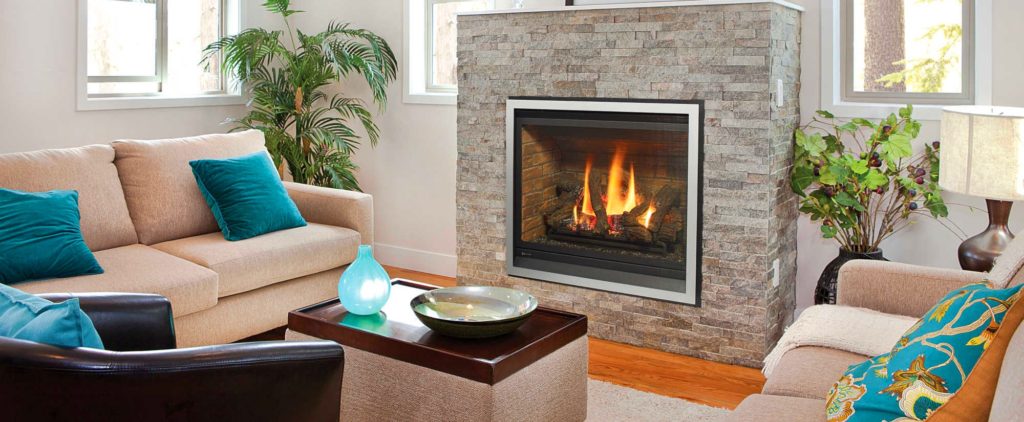

Sometimes you just need a bit of extra heat in a room but don’t want the hassle and cost of turning on the heat for the entire house. The solution is to purchase a ceramic heater. While any portable heater will allow you to heat a small space, ceramic models are much more efficient. It is a constant, energy-saving source of heat, and as a bonus, there is little risk of a fire hazard.
There is a lot to consider when purchasing the best ceramic heater. The total area that it will cover is important, as are the wattage available and options for settings. The dimensions will determine just where you can place your ceramic heater, and if you need it to be portable, then it’s important to know the weight. With that being said, the Lasko 751320 gets our Editor’s Choice.
To help you find the best ceramic heater, we’ve combed through manufacturer information, online reviews, and our personal observations to bring you the eight best ceramic heaters. We begin with a handy comparison chart, followed by in-depth product reviews. We have also put together an informative buying guide that gives you more information about the features to expect from ceramic heaters. Finally, we end by answering frequently asked questions and then giving our top three picks. In the end, we hope that the purchase of your next ceramic heater is as easy as possible.
More features: built-in timer; oscillation; LED indicators; wireless remote control
Lasko is a popular heater manufacturer, and their commitment to craftsmanship is one of the reasons the Lasko 751320 is our Editor’s Pick. With a sleek, tall design, this ceramic heater can work its magic in a variety of rooms. The 1,500 wattage allows for a coverage area of 300 square feet, which means a bedroom or living room can discover the benefits of this ceramic heater.
As for features, the Lasko 751320 has plenty. There is a built-in timer which is perfect for when you want to fall asleep in a cozy setting but don’t want to overheat as the night continues on. There is also a wireless remote control. Sometimes you need to change the room temperature, but it is far more convenient to do so while sitting down. A remote control for your heater is one of those features that you’ll fully appreciate once you own it.
There are two settings for noise, which is again perfect if you are planning on using the heater at night, or if you don’t want it to compete with your favorite TV show. The Lasko 751320 has a built-in thermostat so you can decide exactly what temperature you want your room to be. There’s no more guesswork!
The only real downside is that this is not going to be a very portable heater. While it doesn’t weigh very much, there is no handle, and it is a bit larger than others on our list, and therefore better suited to remain in one area.
More features: tip-over switch; overheat protection; 1.83-meter cable
The best things come in small packages. This is radically true with the Pro Breeze 1500W Mini Ceramic Space Heater. While it only measures 6.5 x 5 x 9 inches, it still creates 1,500 watts of power and can heat a room up to 300 square feet. And, it is incredibly budget-friendly. All these combined means that it’s no wonder the Pro Breeze 1500W Mini Ceramic Space Heater is one of the best rated ceramic space heaters on Amazon. Its 4/5 out of 5 stars rating shows how amazed previous customers were.
The Pro Breeze 1500W Mini Ceramic Space Heater is very easy to use. Turn one dial to one of the three heat settings and then turn the other dial to the desired temperature. Then, wait but a few moments until your room starts to thaw.
There are also plenty of safety features with the Pro Breeze 1500W Mini Ceramic Space Heater. The unit won’t overheat, so there’s no need to worry if you plan on using the heater at night. As well, there is a tip-over switch. This ensures that if the heater falls over, an internal mechanism will recognize this and instantly shut the heater off. A nice feature to use it in any small space, so it’s also a good heater for bathroom or small covered patio.
The compact size of the Pro Breeze 1500W Mini Ceramic Space Heater means that it is extremely portable. Simply pick up and pack it up anywhere you plan on going. And, if you plan on using this heater in the office, it won’t take up any precious space.
More features: built-in carry handle; ETL listed; 11 temperature settings
When it comes to ceramic heaters, Lasko is one of the leading brands. It’s no surprise, then that there are three Lasko products on our list. The Lasko 754200 stands out, which is why we’ve ranked it as the best Lasko ceramic space heater. One of the nicest features of this product is that in addition to the three overall settings, there are a further 11 temperature settings that you can set it to. So, first determine if you want the heater to put out high or low heat, or simply act as a fan, and then decide at which temperature you want your room to feel. No matter what you decide on, the Lasko 754200 will work for you.
If you’re worried about safety, then have no fear as the Lasko 754200 has several safety features. There is an overheat protection which ensures that there is no accident, even if you leave the appliance on overnight. The outside of the heater also has a cool-touch exterior. So, if you need to keep your child’s room a bit warmer at night, this is definitely an option to consider.
Finally, one bonus feature that the Lasko 754200 has is a convenient handle. The handle, combined with its small size and weight, means that it is one of the best portable ceramic heaters on the market. And, with 1,500 watts of power, you can still expect amazing results.
More features: remote control; EcoEnergy function; 24-hour digital timer
When it comes to ceramic heaters, having a tower means you get a bit more power saving a some space at the same time. The DeLonghi TCH7915ER is a prime example. Working hard with 1,500 watts of power, it’s no wonder that this product is one of the best rated ceramic space heaters on Amazon, coming in at 4.5 stars out of 5. Previous users rave about its safety features, ease of use, and of course, its ability to heat a room.
For safety features, the DeLonghi TCH7915ER will prevent overheating thanks to its thermal cut-off design. As well, there is an internal tip over function. Basically, if the heater falls over, the unit will alert itself and automatically turn off. This is so important if you plan on using the heater at night.
The control panel on the DeLonghi TCH7915ER is very user-friendly. The LED screen will tell you exactly what temperature you have set it to. There are multiple settings for the temperature, plus a 24-hour timer. If that wasn’t enough, this ceramic heater also comes with a remote control for more ease of use.
If you are worried about the noise of a heater overpowering a conversation, TV show, or even your sleep, rest assured that the DeLonghi TCH7915ER uses a Silent System which is actually 40% quieter than previous models.
The only drawback with the DeLonghi TCH7915ER is that it has a coverage area of 150 square feet, which is considerably less than other similar products. However, according to previous users, this is an understatement, and the heater will do just fine with most medium or even large-sized rooms.
More features: thermostat dial; oscillation switch; power indicator light
The Ivation IVACFH60 is a really nice middle ground of a ceramic heater. It doesn’t have a lot of fancy bells and whistles but does have the performance you are looking for. In fact, it is ranked as Amazon’s Choice for a Bedroom Heater. With a 1,500-watt power and the ability to heat up to 300 square feet, there’s no wonder it earned this distinction.
When looking to set the right temperature with the Ivation IVACFH60, it couldn’t be easier. There are two dials: the heating settings knob and temperature one. When it comes to managing the room temperature, simply select the desired maximum and minimum. Once the max temperature is being reached, the heater will turn off. However, as soon as the set minimum is reached, the heater will start to heat again. There’s no need to fuss, especially if you want to leave the heater on at night.
One of the most unique features of the Ivation IVACFH60 is that it comes with an air filter. Not many ceramic heaters have this function, especially in this price point. However, if you are worried about your air quality, or just want an extra layer of protection, you can use the Ivation IVACFH60 for its dual purposes. Check the instruction manual for steps on how to clean the filter and when it needs to be done. According to users, though, this process is straightforward. You can have warm and clean air, all at the same time.
More features: remote control; timer for 1,2 or 4 hours; adjustable thermostat
Another item from heating experts, Lasko, the Lasko Designer Series Ceramic Space Heater is one of the more unique products on our list. It is shaped almost like an outdoor patio heater, but is certainly meant for the inside. With a wider cylindrical base and taller height, its dimensions of 8.2 x 8.2 x 16.1 inches can be a bit misleading as it is not a rectangular shape.
This product is meant to be front and center in a room and definitely not hidden in a corner. If you were looking to add a bit of a design element to your room, then the Lasko Designer Series Ceramic Space Heater will win you over with the added bonus that it is also very functional.
As a heater, it uses 1500 watts to heat a room up to 300 square feet. So, whether it’s the living room or bedroom, you can add a bit of pizazz as well as a bit of heat. If a need arises, the unit can become a nice patio heater bringing both warmth and aesthetics to your backyard.
In addition to its unique design, the Lasko Designer Series Ceramic Space Heater comes with a lot of great features. There is a wireless remote control which is perfect for those wanting just to sit and relax. The time allows you to program the heater for one, two, or four hours, which is excellent if you want to use it at night. As well, there is an adjustable thermostat so you can choose the perfect setting. This ceramic heater may not be for everyone, but it certainly will create a bit of buzz for your home.
More features: 4 colors available; tip-over protection
It’s really amazing how advanced technology has become. While it used to take tons of energy to heat a room, not mention a lot of money, in today’s world, you can do so with a small machine for a fraction of the price. You probably are not looking for something too powerful like a heat pump or a kerosene heater, so this is the option to check out then.
Our Budget Pick for the best ceramic heater is the AmazonBasics 500-Watt Ceramic Personal Mini Heater. While it isn’t fancy, it gets the job done and will cost less than the price of a sweater. While it is only powered by 500 watts of energy and is best for smaller spaces, this is still an impressive heater. If you work in an office that is set to a ridiculously low temperature or needs to heat a bedroom in a trailer, then this is the perfect heater for you.
With micro dimensions of 5.9 x 3.2 x 6 inches, the AmazonBasics 500-Watt Ceramic Personal Mini Heater can fit into any corner and be fairly inconspicuous. You can even place it on top of your desk and still have plenty of room for everything else.
For those worried about safety, you can rest assured with this product. It is built with tip-over protection, which means that it won’t fall over even when jostled.
One final bonus is that there are actually four colors you can choose from for the AmazonBasics 500-Watt Ceramic Personal Mini Heater. Black, white, red, or blue: there is a color to match your décor. In the world of standard black heaters, this is a really unique feature.
More features: 120° wide angle oscillation; tip-over safety feature; overheat protection
Sometimes you need the right tool for the right job. If you need to heat a larger room, but not sure which ceramic heater to choose from, the TRUSTECH 1603 can help you out. Able to heat up to 350 square feet, this is the highest coverage area rating on our list, which makes it no wonder we think it is the best ceramic heater for large rooms.
The TRUSTECH 1603 is a quite compact space heater and is just 9.8 inches tall. Moreover, it has a small base, which measures 6.5 x 5.7 inches around means that you can place this heater in the corner of a room and still have it be reasonably inconspicuous.
The base doesn’t seem to be narrow, and there’s no need to worry about the unit as there is a solid tip-over safety feature. So, if your heater gets knocked over, no need to panic as it will automatically turn off, and, if the heater starts to get too hot, it will also turn off on its own.
As for temperature settings, there are plenty of them with the TRUSTECH 1603. It comes with two heating settings: low and high. You can also set the thermostat to your desired temperature. The fan has a cooling feature, as well.
This unit is impressive because of the 120° wide angle oscillation. It allows warming your room evenly. Next, there is a carry handle to move it around with minimal efforts. The heater stays cool while working, except the metal mesh on the front.
Before you purchase the best ceramic heater, we want you to make an informative decision. In our buying guide, we’ve brought together everything you’ve ever wondered about ceramic heaters. From the simple question as to why you should choose a ceramic heater, to the possible features you’ll encounter, we’ve tried to give you all the answers.
On your path to choosing the right heater for your room, you’ve likely stumbled upon the term ceramic heaters. They seem to be everywhere now, but what are they?
Their name comes from the fact that there are ceramic plates inside the heater which hare heated up via electricity. That heat is then transferred to the room, usually with the help of a fan. Ceramic heaters are an excellent choice for three main reasons.
First, they are relatively safe. While you always want to be cautious with any heat source, ceramic heaters are durable and a better alternative to many. Secondly, the small size of the ceramic heaters means they are very portable. You can transfer them from room to room, or easily move them to the garage for storage during the summer. If you plan on taking a trip, they can easily fit inside of a trailer or an RV. Finally, ceramic heaters are relatively inexpensive. While there are many options, all at different price ranges, you can easily afford any basic ceramic heater. Overall, ceramic heaters will do a great job of keeping you warm.
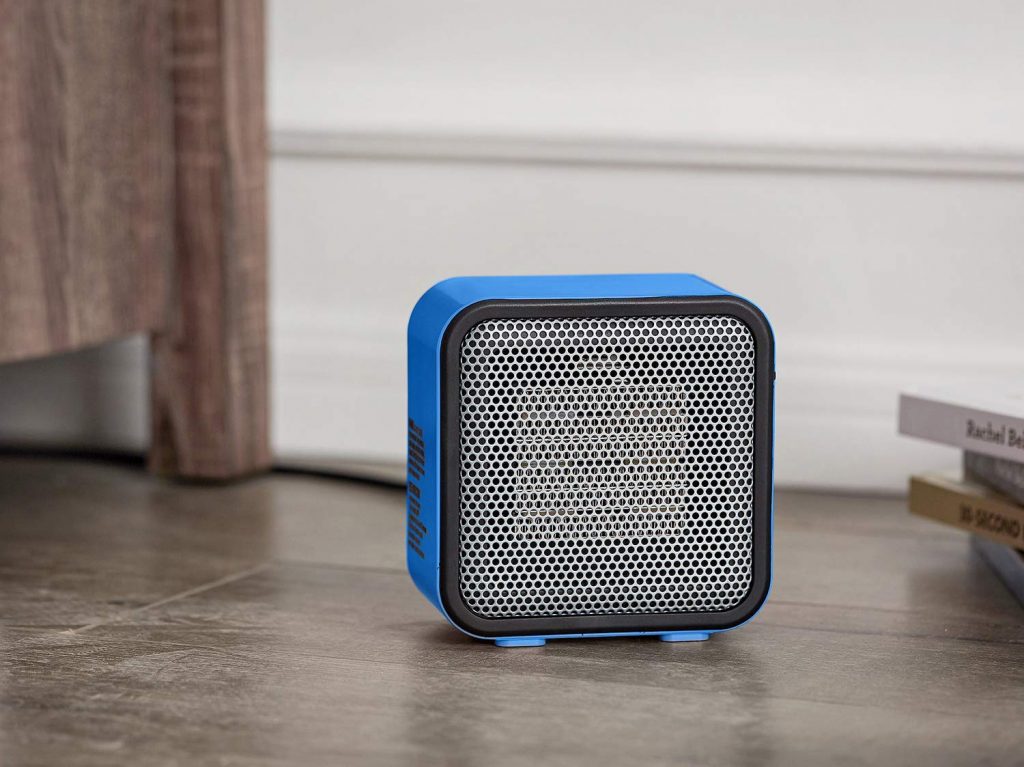
The wattage in a ceramic heater refers to how much power the heater will have. Apart from one product on our list, all of the ceramic heaters we reviewed have a 1,500 wattage power. The AmazonBasics 500-Watt Ceramic Personal Mini Heater is the exception, coming in at 500 watts. While this mini heater will provide a lot of heat, it is best for smaller rooms, or areas that aren’t in a constant deep freeze.
The coverage area of a ceramic heater refers to the size of the room in which the heater can expect to work properly. If you place a heater in too large of a space, it will take much longer than ideal to heat and leave you frustrated with the performance of the heater. The average coverage area of the ceramic heaters on our list is 300 square feet. This means that you can comfortably heat a bedroom or even a living room. If, however, you live in an open-concept home, then you may need multiple ceramic heaters.
The DeLonghi TCH7915ER has the smallest coverage area on our list, at 150 square feet, (which is perfect for a small bedroom or a kitchen), while the TRUSTECH 1603 has the largest coverage area, at 350 square feet.
Be sure to measure the space where you plan on placing your ceramic heater and purchase accordingly.
When it comes to heat settings, the more, the better. We all have individual preferences, and the more accurately you can control the heat from a ceramic heater, the happier you will be. The standard for heat settings is three. This will give you a low, medium, and high temperature options.
While most ceramic heaters will not have a thermostat, if you can find a model with one, it can really change your heating routine. A thermostat means that you can more accurately control which temperature you want your heater to reach. It also means that your ceramic heater will turn off once it reaches that temperature and then turn on again once the room has cooled. The Ivation IVACFH60 is a great example of such a model. This is the most energy-efficient option to choose.
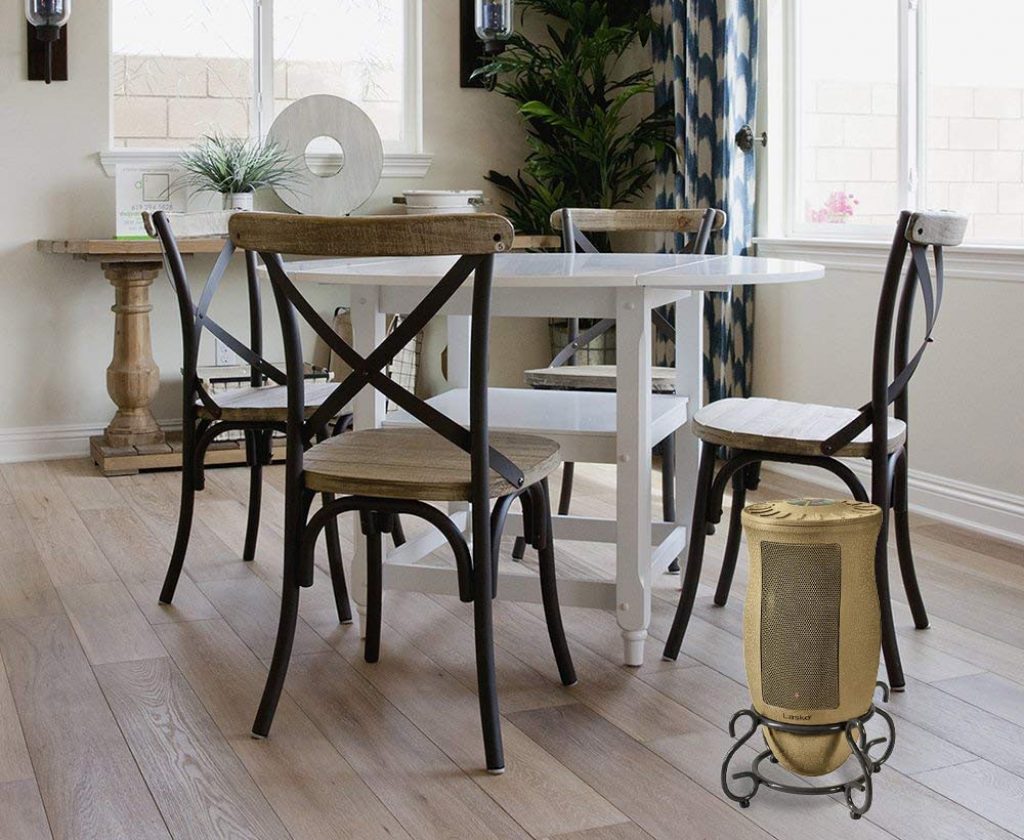
The TRUSTECH 1603 is perfect if you want to put it in a corner. The AmazonBasics 500-Watt Ceramic Personal Mini Heater, as its name implies, is much smaller with dimensions of 5.9 x 3.2 x 6 inches. You can put this mini heater in any small space. So before you purchase a ceramic heater, think about where you want to place it. Whether it’s on the floor or on the counter, there is definitely an option for you.
A ceramic fan has a lot of electrical components, so a warranty is crucial for your purchase. There are many products on our list that come with an impressive three-year warranty, including the Lasko 754200, Lasko 751320, and the Lasko Designer Series Ceramic Space Heater. As you can see, all three heaters come from the same manufacturer. You can also expect really nice customer service from Lasko, so if you are a bit worried about your purchase, there are plenty of options from them available.
Along with the standard features of a ceramic heater mentioned, there may be some bonus characteristics as well. While these often come with a heftier price tag, they are usually worth it and ensure the longevity and usefulness of a ceramic heater.
Above all, a remote control is an excellent feature to have. For those using a heater at night, a remote control means that you can stay in your cozy bed and still control your heater. Likewise, if you’re enjoying some time on the couch and really don’t want to have to get up to turn your heater on, this extra is a savior.
If your ceramic heater has an oscillation feature, it means that it can pivot and spread warmth to the whole room. For larger areas, the oscillation feature is a must. It also means that the room will heat up faster.
While some ceramic heaters are boxy in size and therefore sturdier, some are tall and lean. Tip-over protection means that your ceramic heater has been developed so that it won’t fall over, even if jostled. This gives great peace of mind to all users.
One final extra feature is an eco-mode. Often used in conjunction with a thermostat, eco-modes allow for sensors to shut off the heater once it’s reached the desired temperature and then to turn on again if that temperature drops. This means that you aren’t needlessly heating your room.
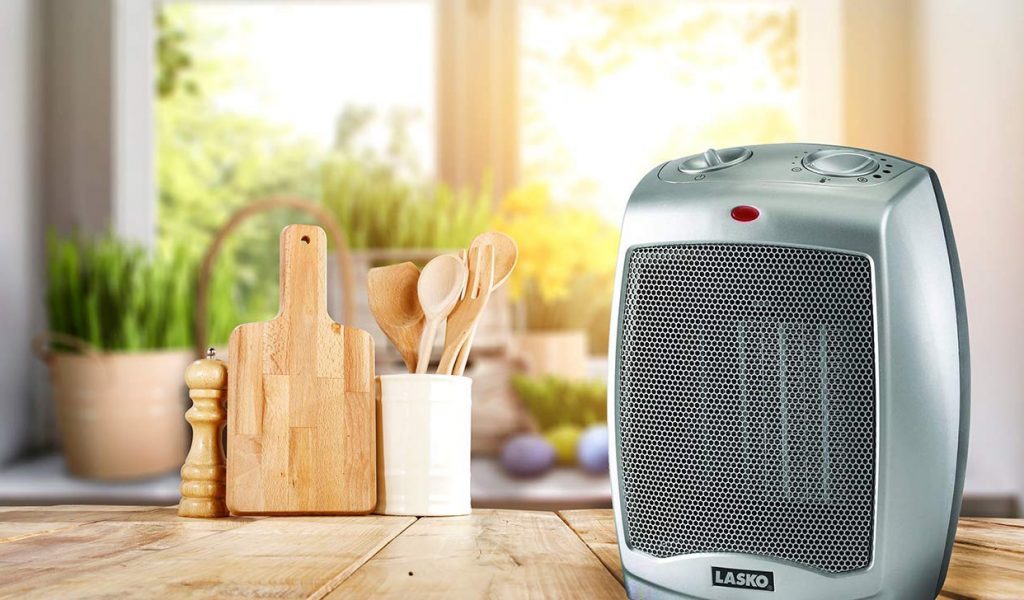
First of all, make sure that your heater is on a flat surface. The floor is the best option, but a countertop will also do. The next aspect to consider is what is around the heater. There should be no fabrics, such as clothes or curtains near the appliance. There should also be no papers in the area. To be on the safe side, make sure there is at least one to two feet of clear space around your heater.
While you may want to put a heater on a shelf, the walls around the heater can impede and create a safety hazard. You’ll want adequate air flow around the heater.
Before you plug your ceramic heater in, read the instruction manual, and set up your device accordingly. Finally, ensure that the room you place your ceramic heater in has a working smoke detector. This should be in place regardless if you have a heater or not. Your smoke detector should be tested regularly, and the batteries should be replaced every six months.
Once all these safety tips have been noted, it’s time to enjoy your new ceramic heater.
Hopefully, the search for the best ceramic room heater is over.
If you’re a fan of Laska, then the Lasko 754200 is perfect for you. With this model, you can not only choose certain modes but also adjust the temperature with its 12 settings. If you are short on space but need a product that will deliver results, the Pro Breeze 1500W Mini Ceramic Space Heater is a must. It is compact, highly portable, but still able to heat medium-sized rooms. Finally, our Editor’s Choice for the best ceramic heater is the Lasko 751320. Packed with all the bells and whistles you could want in a heater, while still also affordable, this heater will keep you warm and toasty, even on the coldest winter night.
